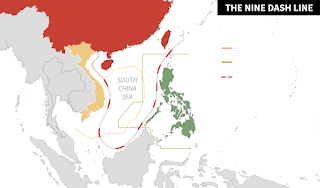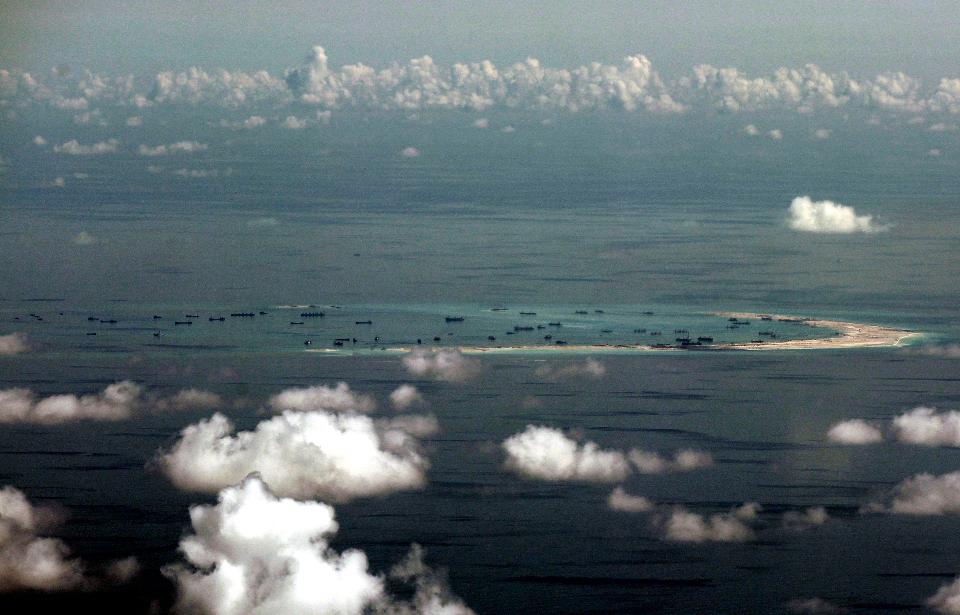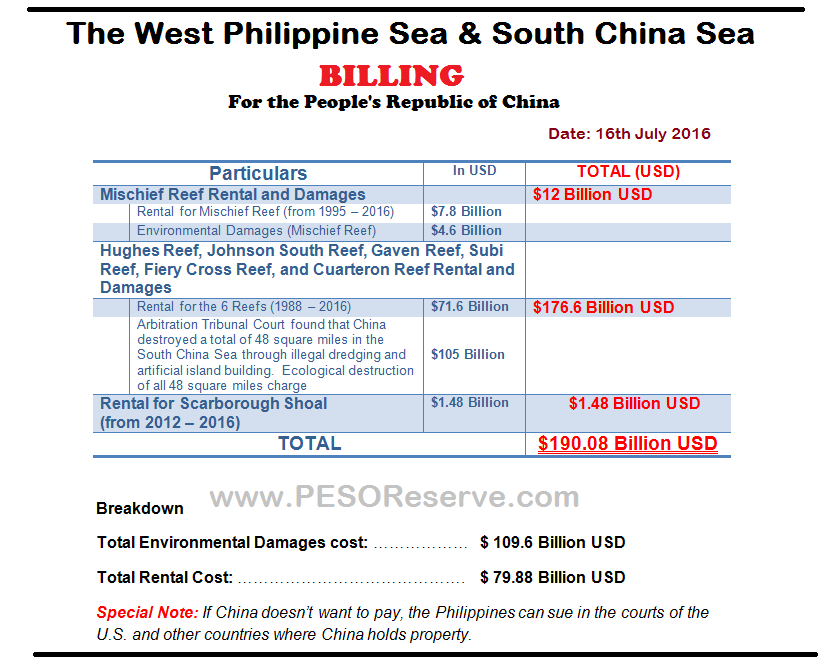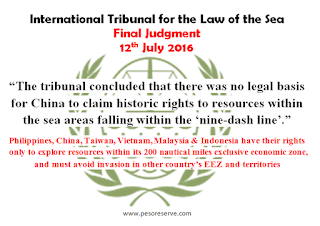
A Chinese Coast Guard boat sprays a water cannon at Filipino fishermen near Scarborough Shoal in the South China Sea last year. Photo: AP
At what point does a lonely rock in a vast ocean become an island? Just how much land is needed to sustain human life?
And when China dredges thousands of tons of sand from the sea floor to build a runway, is Beijing right to claim the waters surrounding an artificial island as its own territory?
An international court is about to rule on these crucial questions in the bitterly contested waters of the South China Sea, in one of the most eagerly awaited decisions in global politics right now.
It could also mark the moment Australia has come to dread: when the brewing rivalry between the United States and China finally breaks into a storm.
The South China Sea is a critical artery of world trade; about $US5 trillion worth of oil, gas, resource and "Made in China" goods are shipped across these waters back and forth from the powerhouse economies of Asia, including about 60 per cent of Australia's exports, according to government estimates.
But who exactly controls the South China Sea has been a stubborn regional dispute lasting decades - not just for the navigation channels, but just as importantly, the riches thought to lie beneath the waves in vast untapped oil fields and highly prized fish supplies.
Suddenly this regional dispute over rocks and coral beaches shapes as a critical test between China's willingness to thrown its weight around and Washington's insistence that Beijing should follow the existing rules it has policed over decades as the global superpower.
The US has been keen to ensure the court decision gets as much publicity as possible, while China has responded in the last week with naval war games and disdain.
Australia has been carefully watching, a key ally for Washington and a major trading partner for Beijing, knowing these are the kind of disputes that can determine geopolitical destiny.
The ruling is expected on July 12 and four main issues could have profound consequences for the balance of power in the neighborhood.
1. A hungry 'cow's tongue'
The Philippines has lodged a case against China under the Law of the Sea in the Permanent Court of Arbitration at The Hague, even though China has refused to participate.
Six countries claim overlapping parts of the South China Sea, creating a dangerous flashpoint for potential conflict in roughly 3.5 million square kilometers of open water, shoals and coral atolls teeming with fish and oil, and a key ocean passage for thousands of cargo ships passing through Asia.
But China's bid for territorial control sweeps across almost all others, shown on maps by a deliberately vague dotted line that hooks deep in a U-shape past the coast of Vietnam, towards Indonesia, and close to the western islands of the Philippines.

South China Sea and West Philippines Sea overlapping claims. Illustration: The Sydney Herald Morning Post
Known as the "nine-dash line" - which Vietnam likens to a hungry "cow's tongue" for the way it licks across the region - China claims its control of the waters dates back to ancient times, marked in 600-year-old mariners' books.
The Philippines has asked the court, among a log of 15 technical claims, to rule China's "nine-dash line" is inconsistent with the modern Law of the Sea, which is based on geological features.
"That is absolutely the most important question put before the tribunal," Jay Batongbacal, a professor of international maritime law at the University of the Philippines, tells Fairfax Media.
The court hasn't yet said it has jurisdiction on this question, and it cannot decide issues of sovereignty - who owns what.
But if the court does weigh the question of the nine-dash line, there is little expectation that it will grant legal backing to the idea of "historic rights".
The ruling might prod China to precisely explain exactly what it claims, instead of resorting to what is seen as deliberate ambiguity.
2. Life, but not as we know it
It was a big risk for Philippines to take on China, by far its largest trade partner. The court decision may also completely upend Manila's own territorial claims.
The Philippines have challenged the court to decide whether a small stretch of land, just longer than a kilometer, is actually an island or just a big rock.
The difference is crucial for international law in deciding how much surrounding territory can be claimed.
Taiwan presently occupies this land, the largest feature of dozens of rocky outcrops and reefs in the Spratly Island chain, calling it "Taiping Island".
The Philippines calls it "Itu Aba", and says it has no fresh groundwater to sustain human life and so is better described for legal purposes as a rock.

Itu Aba. Illustration: The Sydney Herald Morning Post
But if the court says Itu Aba (it has adopted the Philippines' name for it) is indeed an island, then under the Law of the Sea the "island" will be entitled to 12 nautical miles of surrounding waters as its territory, and a 200-nautical-mile exclusive economic zone.
But in the shallow waters of the Spratly Islands, such a ruling could effectively knock out many of the Philippines' territorial claims too.
Taiwan insists Itu Aba can sustain life, and to prove it has stationed roughly 200 coast guard and scientists there, while also shoring up land for an airstrip there to fly in supplies.
Should the court's judgement rest on the conditions on Itu Aba now, as opposed to before human habitation, that will have interesting consequences for what has been the most contentious aspect of China's recent island-building actions.

3. 'Tourism appears unlikely'
China has been terribly busy in the past couple of years constructing a series of what movie fans would recognize as the arch-villain's hideouts - except that it makes little effort to keep these artificial islands secret.
Coral atolls in the South China Sea have been transformed into airfields, with dozens of storage sheds and dredged sand cutting deep ports.
In more sinister developments, China has also stacked weapons, radar towers and other military hardware on reclaimed land. In April, a military aircraft landed on one artificial island.

China's construction has been widely condemned; Australia's defense chief queried the need, dryly observing that "tourism appears unlikely".
The Philippines has asked the court to rule that Mischief Reef, Subi Reef and Fiery Cross Reef, among others that have been occupied by China and substantially transformed, should not qualify as islands but are actually just rocky outcrops which are only visible at low tide.
While that was true a couple of years ago, before China's construction work began, it's a 50-50 question which way the court might rule, and whether its decision will rest on the situation then or now.

The US has dispatched warships to sail inside the 12-nautical-mile zone around China's artificial islands, just to reinforce the point that Washington does not recognize the surrounding waters as sovereign territory.
A heated debate has erupted about whether Australia should also undertake these "freedom of navigation exercises", either with a vessel or by flying a patrol jet nearby.
The Philippines also wants the court to rule on China's aggressive behavior, especially around Scarborough Shoal, which China seized in 2012 and where it has sent its coast guard to harass foreign fishing vessels.
Scarborough Shoal is roughly 350 kilometers from Manila, yet more than 900 kilometers from China's mainland.
The court has also been asked whether Beijing has breached environmental obligations. Curiously enough, this includes Second Thomas Shoal, where the Philippines deliberately ran aground a rusty navy ship to serve as a military outpost, which China has often frustrated attempts to resupply.

4. The wild card
The US has deliberately fanned expectation about the upcoming court ruling, knowing that international diplomacy only ever produces a few tangible moments that register in the public mind as definitive.
But despite the hype, the ruling will not end the South China Sea stand-off.
China has already pledged to ignore the ruling, and has been busily attempting to gather its own motley crew of international supporters.
The US emphasis (echoed by Australia) is to solve the dispute through the "rules-based order", given that both the Philippines and China have ratified the United Nations Convention on the Law of the Sea.
But the US never has, which Malcolm Turnbull has warned diminishes Washington's leadership.
China is also permitted, under law, to exempt itself from arbitration - just as Australia has done in its maritime boundary dispute with East Timor.
What is really at stake here is who gets to enforce the rules and the age-old question of might versus right.
China insists the South China Sea dispute should be resolved country-to-country, without allowing pesky jurists to get in the way. This conveniently ignores its massive preponderance of power over its near neighbors.
But there is a wild card.
The Philippines has a new president, Rodrigo Duterte, with a reputation as a firebrand.
Duterte has threatened to jump aboard a jet ski to Scarborough Shoal to assert the Philippines' claim.
But he has also flagged a more conciliatory attitude towards Beijing.
China has turned on the charm since Duterte won election in May, with reports that Filipino fishermen are increasingly permitted to fish unhindered near Scarborough Shoal in the past few weeks.
"If it goes on still waters, I said, [if] there's no wind to move the sail, I might opt to go bilateral," Duterte said he told Barack Obama, one of several cryptic comments that leave analysts wondering what action he might take after the ruling.- The Sydney Morning Herald

































